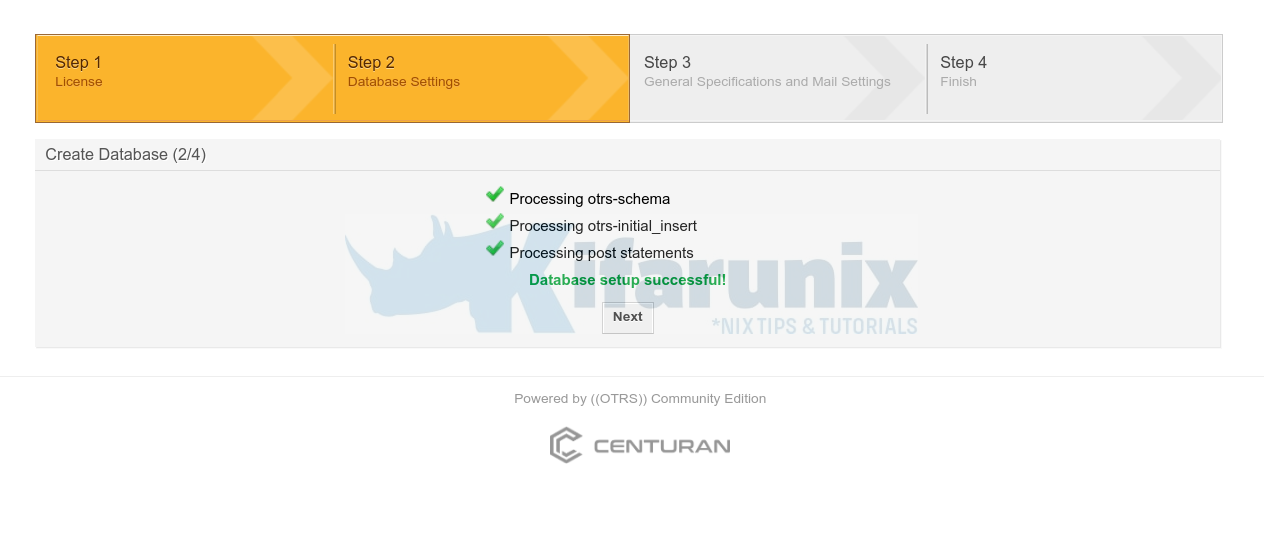Welcome to our tutorial on how to install OTRS ticketting system on Debian 11. OTRS, an acronym for Open Source Ticket Request System, is a flexible ticket request and process management system for customer services, Helpdesk, and IT services.
OTRS ships with a comprehensive list of features that you can check them on the OTRS feature list page.
Install OTRS Ticketting System on Debian 11
OTRS is available as a commercial product as well as a community edition. In this tutorial, however, we will learn how to install OTRS community edition on Debain 11 system from the source code.
To begin with;
- Create OTRS system user account
sudo useradd -r -m -d /opt/otrs -c "OTRS User" -s /usr/sbin/nologin otrs- Install Required Build Tools
sudo apt install perl libapache2-mod-perl2 libdbd-mysql-perl libtimedate-perl \
libnet-dns-perl libnet-ldap-perl libio-socket-ssl-perl libpdf-api2-perl \
libdbd-mysql-perl libsoap-lite-perl libtext-csv-xs-perl libjson-xs-perl \
libapache-dbi-perl libxml-libxml-perl libxml-libxslt-perl libyaml-perl \
libarchive-zip-perl libcrypt-eksblowfish-perl libencode-hanextra-perl \
libmail-imapclient-perl libtemplate-perl libmoo-perl libauthen-ntlm-perl \
libjavascript-minifier-xs-perl libdbd-odbc-perl libcss-minifier-xs-perl \
libdbd-pg-perl libdatetime-perl apache2 mariadb-server mariadb-client -y- Download latest OTRS Source Code from the download’s page and extract it to /opt directory.
wget -qO- \
https://otrscommunityedition.com/download/otrs-community-edition-6.0.35.tar.gz \
| tar xz -C /opt/otrs --strip-components=1- Next, run the OTRS Perl script to check if all required modules are in place.
perl /opt/otrs/bin/otrs.CheckModules.plSample command output;
o Apache::DBI......................ok (v1.12)
o Apache2::Reload..................ok (v0.13)
o Archive::Tar.....................ok (v2.36)
o Archive::Zip.....................ok (v1.68)
o Crypt::Eksblowfish::Bcrypt.......ok (v0.009)
o CSS::Minifier::XS................ok (v0.11)
o Date::Format.....................ok (v2.24)
o DateTime.........................ok (v1.54)
o DateTime::TimeZone.............ok (v2.47)
o DBI..............................ok (v1.643)
o DBD::mysql.......................ok (v4.050)
o DBD::ODBC........................ok (v1.61)
o DBD::Oracle......................Not installed! (optional - Required to connect to a Oracle database.)
o DBD::Pg..........................ok (v3.14.2)
o Digest::SHA......................ok (v6.02)
o Encode::HanExtra.................ok (v0.23)
o IO::Socket::SSL..................ok (v2.069)
o JSON::XS.........................ok (v4.03)
o JavaScript::Minifier::XS.........ok (v0.13)
o List::Util::XS...................ok (v1.55)
o LWP::UserAgent...................ok (v6.64)
o Mail::IMAPClient.................ok (v3.42)
o IO::Socket::SSL................ok (v2.069)
o Authen::SASL...................ok (v2.16)
o Authen::NTLM...................ok (v1.09)
o ModPerl::Util....................ok (v2.000011)
o Moo..............................ok (v2.004004)
o Net::DNS.........................ok (v1.29)
o Net::LDAP........................ok (v0.68)
o Net::SMTP........................ok (v3.11)
o Template.........................ok (v2.27)
o Template::Stash::XS..............ok (undef)
o Text::CSV_XS.....................ok (v1.45)
o Time::HiRes......................ok (v1.9764)
o XML::LibXML......................ok (v2.0134)
o XML::LibXSLT.....................ok (v1.99)
o XML::Parser......................ok (v2.46)
o YAML::XS.........................ok (v0.82)
If any Perl module is missing, install using the package manager or CPAN.
- Activate the default OTRS configuration,
/opt/otrs/Kernel/Config.pm.dist, by renaming it to remove the.distextension;
cp /opt/otrs/Kernel/Config.pm{.dist,}Once you activate the configuration file, check if other required modules are okay;
for i in cgi-bin/index.pl cgi-bin/customer.pl otrs.Console.pl; do \
perl -cw /opt/otrs/bin/$i; doneSample Output;
/opt/otrs/bin/cgi-bin/index.pl syntax OK
/opt/otrs/bin/cgi-bin/customer.pl syntax OK
/opt/otrs/bin/otrs.Console.pl syntax OKEnsure everything is Okay before you can proceed.
- Run MySQL initial security script;
mysql_secure_installation- Create OTRS Database and Database User
mysql -u root -p -e "create database otrsdb character set utf8 collate utf8_general_ci;"mysql -u root -p -e "grant all on otrsdb.* to otrsadmin@localhost identified by 'ChangeME';"mysql -u root -p -e "flush privileges;"Update the database configuration with the settings below;
max_allowed_packet = 64M
query_cache_size = 32M
innodb_log_file_size = 256MPlease these lines within the [mysqld] section. Use the command below;
sed -i.bak -e \
'/\[mysqld\]/amax_allowed_packet = 64M\nquery_cache_size = 32M\ninnodb_log_file_size = 256M' \
/etc/mysql/mariadb.conf.d/50-server.cnfRestart the database service;
systemctl restart mariadb- Setup Apache OTRS Site Configuration
By default, OTRS ships with default Apache configuration, /opt/otrs/scripts/apache2-httpd.include.conf.
Thus, instead of re-inventing the wheel, just link this configuration file to Apache sites-enabled directory to use it to serve OTRS.
ln -s /opt/otrs/scripts/apache2-httpd.include.conf /etc/apache2/sites-enabled/Disable the default Apache site configuration;
a2dissite 000-default.confNext, enable the required Apache modules;
a2enmod perl version deflate filter headersSet the ownership of the /opt/otrs;
chown -R otrs: /opt/otrs/usermod -aG www-data otrsUpdate OTRS Files Permissions
/opt/otrs/bin/otrs.SetPermissions.pl --web-group=www-dataCheck Apache configuration for any error and restart Apache Web Server;
apachectl -tsystemctl restart apache2Finalize Setup of OTRS on Browser
Allow external access to Apache service;
ufw allow 80/tcpNext, access the OTRS installer via the http://HOST_IP_OR_DOMAIN/otrs/installer.pl.
- On the first step, you need to Accept End User License Agreement. Thus click Next and scroll down and accept the license.
- Define OTRS database connections details created above. If you have not already created the database, you can choose to create a new one.
Thus select “Use an existing database for OTRS” and proceed to define the database connection details.
Once you enter the database connection settings, verify the connection before you can proceed.
The database setup will proceed when you click Next.
Once it is done, click Next.
- OTRS general and Mail settings;
Click Next to configure your email settings.
- OTRS Login Credentials
At the finish, you will see the OTRS login details.

- OTRS Dashboard

If you see that the OTRS Daemon is not running, start the OTRS Daemon;
sudo -Hiu otrs /opt/otrs/bin/otrs.Daemon.pl startNext, ensure that the OTRS cron jobs under /opt/otrs/var/cron/ exists without the .dist extension and start them;
sudo -Hiu otrs cp /opt/otrs/var/cron/aaa_base{.dist,}sudo -Hiu otrs cp /opt/otrs/var/cron/otrs_daemon{.dist,}sudo -Hiu otrs /opt/otrs/bin/Cron.sh startAnd that is all!
Read more on the administration page.







Hi.
Very cool tutorial to setup OTRS on Debian 11. I could follow everything and all makes sense. But I am hanging at the end as I receive the Message on top of the web client that the OTRS Daemon is not running and I tried “sudo -Hiu otrs /opt/otrs/bin/otrs.Daemon.pl start”. But any of the last four commands return: This account is currently not available.
What to do?
Hi,
you need enable otrs account
sudo chsh -s /bin/bash otrs